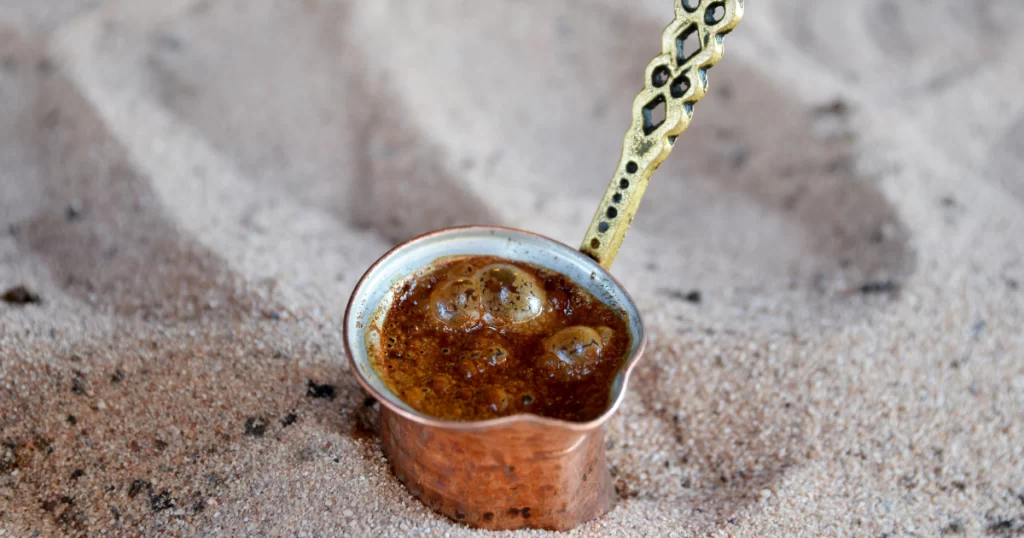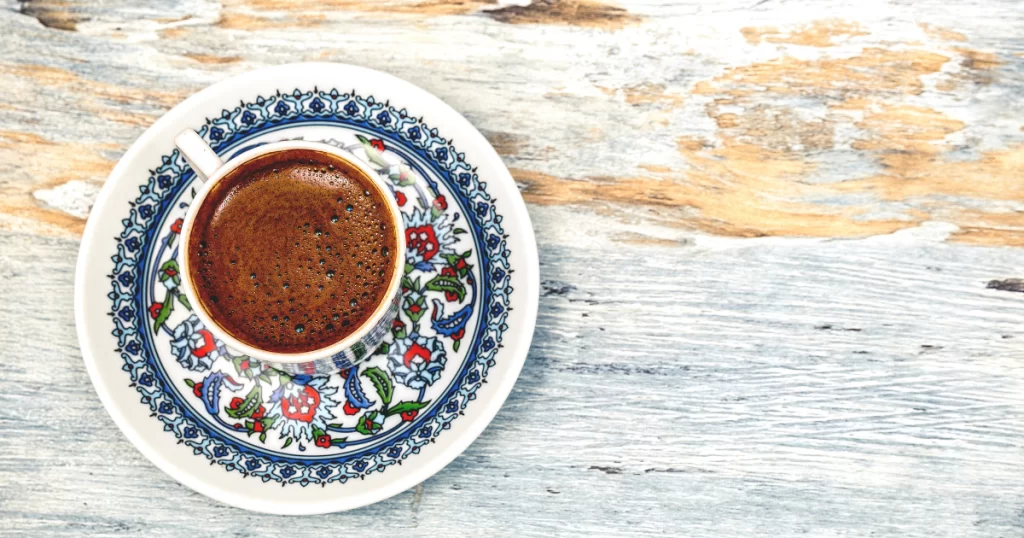Turkish coffee is a true delight, known for its unique preparation method, intense flavor profile, and cultural significance.
It involves grinding the coffee beans to an ultra-fine powder and brewing it in a traditional small copper pot known as a cezve.
You can expect it to be intense in taste but also has a distinctively thick and rich texture. But how exactly is it different from others? Let’s explore it.
💡 Make sure to follow the best Turkish coffee recipe for the most authentic and traditional taste.
Turkish coffee: What is it?
This unique brewing method has a rich history and an intriguing origin story. Hailing from the Ottoman Empire, it has been perfected over centuries to create a cup of coffee that is truly exceptional.
Origins of Turkish coffee
This beloved beverage traces its roots to the Ottoman Empire, where it was first introduced in the late 16th century. According to Kahve Cafe, this beverage was presented to Sultan Suleyman the Magnificent by his Governor, which he brought from Yemen.
Soon, coffee houses began to spring up throughout the empire, becoming vibrant hubs of social activity where people would gather to enjoy this newly discovered elixir.
The Ottoman Empire’s love affair with coffee eventually spread to Europe and beyond, captivating drinkers with its unique flavors and brewing technique.
It became an integral part of social rituals, from intimate gatherings to grand ceremonies. In fact, the method of coffee brewing was included in UNESCO’s Representative List of the Intangible Cultural Heritage of Humanity in 2013, acknowledging its significance.
Turkish coffee: How to make it?
This is one of the oldest brewing methods. To make Turkish coffee, you’ll need some essential tools.
Grab a cezve, a small copper pot with a long handle, to brew your coffee. Choose freshly roasted and finely ground Arabica coffee beans for the best flavor.
You’ll also need a set of demitasse cups to serve your coffee in true Turkish style. Measure the water using the coffee cup you plan to use for serving. The cup size is typically 2-3 ounces.
Pour the water into the cezve, add one teaspoon of coffee per cup, and add sugar optionally.
Stir the mixture gently but thoroughly to ensure the coffee is well-distributed in the water. Resist the temptation to stir again. Let the coffee mixture heat slowly until it reaches a gentle boil. You’ll notice a frothy layer called “kaimaki” as it begins to boil.
Just before the coffee reaches a boil, remove it from the heat and pour it into the cup. Let it sit for 1 minute so that all grounds can settle.
Pro tip: Hold the cup at a slight angle and slowly pour the coffee to avoid losing the valuable foam.

Coffee beans grind size
Turkish coffee requires an exceptionally fine grind, finer than any other brewing method. This ultra-fine grind sets it apart from the rest and contributes to its distinct taste experience.
The coffee beans are ground to a powder-like consistency. This fine grind allows maximum surface area contact with the water during brewing, resulting in a concentrated and intense flavor profile.
The grind size is even finer than the espresso grind, which is already quite fine. While espresso grind is like sand, Turkish coffee grind is more similar to flour or powdered sugar.
Turkish coffee foam
The foam in Turkish coffee is unique because it is created during the brewing process rather than being added afterward. It is similar to the crema that espresso has, but it is much thicker and stronger.
On the other side, it is the opposite of the foam that cappuccino or latte has, which is created by steaming and frothing milk. The foam in this Turkish beverage consists solely of coffee compounds.
Turkish coffee-drinking ritual
The ritual begins with carefully preparing coffee, a process that requires patience and attention to detail. A fresh aroma of coffee fills the air, setting the stage for what is to come.
Once the coffee is ready, it is time to gather with loved ones, friends, or strangers to partake in this shared experience.
Turkish coffee is traditionally served in really small cups, with each cup holding a small serving of the rich and flavorful brew.
The cups are typically delicate and beautifully adorned, adding an aesthetic element to the experience.
The act of serving Turkish coffee is a gesture of hospitality and warmth, as the host carefully pours the coffee into each cup, ensuring that the foam is evenly distributed.
Before taking the first sip, it is customary to let the coffee settle and cool slightly. As a result, sediment sinks to the bottom of the cup, creating a distinct layer.
The ritual of drinking Turkish coffee goes beyond the sensory experience. It is a time for connection and conversation as friends and loved ones come together to share stories, laughter, and moments of genuine connection.
The small demitasse cups encourage a slower pace, creating an atmosphere conducive to meaningful conversations and cherished memories.

Turkish coffee taste
Its flavors are intense, bold, and full-bodied when it comes to taste, leaving a lasting impression on your taste buds. The delicate balance of sweetness and bitterness, combined with the richness of the coffee oils, creates a complex and satisfying experience.
If you’re curious to dig deeper into the taste of Turkish coffee, you need to read this.
Turkish coffee vs. other types of coffee
In Serbia, Bosnia, Cyprus, and Greece, Turkish coffee is called domaća kafa, kafa, kypriakos kafes, and ellinikos kafes. Similarly, Lebanese coffee closely mirrors its Turkish sibling.
The reason for this similarity, despite the different names, lies in history. The Ottoman Empire, at the height of its power, covered all these regions.
Some regions introduce additional ingredients to this brew, crafting unique variations. Arabic, Egyptian, and Armenian coffees are prime examples of this.
In comparison to espresso, Cuban coffee, and regular coffee, this Turkish beverage stands out for its preparation, serving style, and, consequently, its flavor profile.
What is strength?
This brew packs a punch that will jolt you awake and keep you buzzing throughout the day.
Sipping on a cup of this brew is like taking a shot of espresso but with a more intense and long-lasting taste.
To learn more about the strength of Turkish coffee, check out this article.
Final thoughts
This bellowed Turkish brew is more than just a caffeinated drink; it is an experience of culture, history, and exceptional taste.
Savoring Turkish coffee, one sip at a time, is truly a bridge between the ordinary and the extraordinary, a celebration of our shared love for this dark elixir.
So, the next time you find yourself yearning for a cup of coffee, remember the Turkish way – steeped, not just in hot water, but in a sea of enchanting rituals and traditions.
My journey through renowned bars and coffee shops over five years, as a barista, coffee aficionado, and former bartender, has honed my pursuit for the perfect cup. My passion for coffee isn’t just about the brew—it’s about sharing the knowledge and insights I’ve gleaned along the way.



